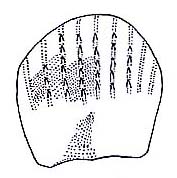ソコダラ科
- HOME
- デジタル図鑑
- パタゴニア海域の重要水族
- 硬骨魚綱 タラ目
- ソコダラ科
ソコダラ科(Macrouridae)

38 マタムアソコダラ(Matamua-sokodara)
Mahia matamua McCann et Mcknight, 1980
特 徴:
背鰭2棘,9〜10軟条 約125軟条,臀鰭 約110軟条,胸鰭17〜20軟条,腹鰭7軟条,鰓耙数9〜11,側線上方鱗数5,臀鰭起部までの側線鱗数11〜13。頭長は臀鰭前長の73.5〜74.8%,骨質眼窩径は30.0〜32.3%,体高は44.1〜49.5%,吻長は19.7〜22.5%,両眼間隔は12.7〜15.3%,上顎長は23.1〜25.3%,第1背鰭高は42.8〜49.9%,胸鰭長は44.1〜49.0%,腹鰭長は22.8〜27.2%。体は延長して尾部は糸状に伸長し,体後半部はかなり側扁するが,頭部はやや縦扁し,著しく大きく,臀鰭前長は頭長の1.3倍。吻は長く尖って,背面観は三角形状で,口は吻の下面下に含まれる。口は伸出可能。眼は極めて大きく,頭長は眼窩径の2.3〜2.5倍。下顎先端に微小な髭がある。両眼間隔域はわずかに凹み,2隆起が主上顎骨の上縁部から前方に伸びる。主鰓蓋骨の後縁は凹む。両顎に歯帯が発達する。鋤骨と口蓋骨に歯はない。擬鰓はない。鰓耙はコブ状。頭部と体部は3〜8列の後方に向う微小棘を備える櫛鱗でおおわれる。第1背鰭は大きく,その基底は短く,胸鰭起部上方から始まる。第2背鰭は低く,その基底は長い。臀鰭は第2背鰭より高く,その基底は長いが,第2背鰭基底よりやや短い。胸鰭は長く,胸鰭長はほぼ第1背鰭起部下の体高に等しい。腹鰭の外側鰭条は内側鰭条より長く,その起部は胸鰭起部よりわずかに前方に位置する。側線は単線で,前半部はゆるやかに下降するが,後半部は直線状で尾部に達する。肛門は臀鰭直前に開く。
分 布:
チリ パタゴニア;ニュージーランドと南アフリカからも知られている。
備 考:
本種はMcCann and McKnight(1980)によりニュージーランドで記載された。今回チリ パタゴニアから得られた標本はM. matamuaの記載と極めてよく一致するので,本報告はM. matamuaのチリ海域での初記録と考えられる。
(中村 泉)
Material examined:
8 from Chile (230.6-342.0 mm TL), FAKU CP 122, 123, 138-141. 525, 581.
Description:
D Ⅱ, 9-10, ca. 125; A ca. 110; P1 17-20; P2 7; GR 9-11; Scales above LL 5; LLS till above anal origin 11-13;.
HL 73.5-74.8 % of PreA; BO 30.0-32.3; BD 44.1-49.5; SN 19.7-22.5; IO 12.7-15.3; UJ 23.1-25.2; D1H 42.8-49.9; P1L 44.1-49.0; P2L 22.8-27.2.
Body compressed and elongate with slightly depressed head. Head very large, 1.3 times in preanal length. Snout short and triangular in shape with pointed tip, well anterior to mouth, its length two-thirds of orbit diameter. Eye very large, 2.3-2.5 times in HL. Interorbital region slightly concave with two ridges extending from upper insertion of opercle, its width 2.3-2.4 times in orbit diameter. Minute barbel on chain. Posterior margin of opercle concave. Mouth inferior, protractile. Villiform teeth in bands on both jaws. No teeth on vomer or palatines. No pseudobranchiae. Gill-rakers nub-like. Ctenoid scales on head and body. Each scale with fine spines directing backward in 3-8 rows. First dorsal fin large, dusky in color, its origin above pectoral fin origin. Pectoral fin long, about equal to body depth at first dorsal fin origin. Pelvic fin rays 7, its origin slightly anterior to below pectoral fin origin, outer ray filamentous. Anal fin well developed and higher than dorsal fin, its longest ray equal to orbit diameter. Single lateral line running from upper insertion of opercle to caudal fin base gradually curving anteriorly, ending straight posteriorly. Luminescent organ present. Anus situated just anterior to anal fin origin. Area around belly, branchiostegal membrane, pelvic fin and anal fin very dark.
Distribution:
Chilean Patagonia; also known from New Zealand (McCann and McKnight, 1980), and South Africa (Iwamoto, in press).
Remarks:
This seems to be a new record of M. matamua for the Chilean ichthyofauna.
(Izumi NAKAMURA)

Distribution of Mahia matamua in Patagonia.

Scale below lateral line.